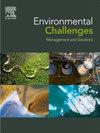Influence of host plant selection on salinity tolerance and antioxidative defense in Sandalwood (Santalum album L.)
Q2 Environmental Science
引用次数: 0
Abstract
Sandalwood (Santalum album) has been highly valued in India for centuries. However, detailed and comprehensive information on the physiological and biochemical changes in sandalwood particularly when associated with host plant species under salinity stress, is currently lacking. Considering the immense potential of sandalwood, an experiment was conducted under controlled conditions by growing sandalwood with ten different host plants and irrigated with good quality water (control: ECiw∼0.82 dS m-1) and saline water (ECiw∼6 dS m-1). Results indicated host-dependent significant variations in sandalwood growth under both controlled and salinity-stressed conditions. Among the different host plant species, Melia dubia, Dalbergia sissoo, and Azadirachta indica improved the plant height (46 %), biomass (45 %), haustoria number (120 %) and diameter (75 %) of sandalwood as compared to rest of the hosts under saline condition. These three host species also improved the physiological processes of sandalwood, such as, SPAD value (up to 22.55), proline content (by 460 %), membrane stability with electrolyte leakage as low as 10.85 %, K⁺/Na⁺ ratio (>1.0). Meanwhile, reduction in lipid peroxidation (by 10 %) and H₂O₂ accumulation were observed. Similarly, non-enzymatic antioxidants of sandalwood under salinity stress increased by over >40 %. Antioxidative enzyme activities, particularly superoxide dismutase, were upregulated by up to 50 % under salinity stress, with the highest increase observed in sandalwood grown with M. dubia. Principal component analysis indicated that D. sissoo and M. dubia are the most favourable hosts for sandalwood under salinity stress, while Citrus aurantium is the least supportive. Overall, findings suggested that M. dubia and D. sissoo are the most important species in the alleviation salt stress in sandalwood. Consequently, this presents an opportunity to establish high- value sandalwood-based plantations in saline ecologies.
寄主植物选择对檀香耐盐性和抗氧化防御的影响
几个世纪以来,檀香在印度一直受到高度重视。然而,关于檀香生理生化变化的详细和全面的信息,特别是与寄主植物物种在盐度胁迫下的相关信息,目前还缺乏。考虑到檀香的巨大潜力,在控制条件下,用10种不同的寄主植物种植檀香,并用优质水(对照:ECiw ~ 0.82 dS m-1)和盐水(ECiw ~ 6 dS m-1)灌溉。结果表明,在控制和盐度胁迫条件下,檀香的生长具有显著的宿主依赖性。在不同寄主植物中,苦楝、黄檀和印楝在生理盐水条件下对檀香的株高、生物量、吸器数和直径分别提高了46%、45%、120%和75%。这三种寄主还改善了檀香的生理过程,如SPAD值(高达22.55)、脯氨酸含量(提高460%)、膜稳定性(电解质泄漏低至10.85%)、K + /Na +比值(>1.0)。同时,观察到脂质过氧化(减少10%)和H₂O₂积累。同样,盐胁迫下檀香的非酶抗氧化剂增加了40%以上。抗氧化酶活性,特别是超氧化物歧化酶,在盐度胁迫下上调高达50%,其中在与杜双歧杆菌一起生长的檀香中观察到的增幅最大。主成分分析结果表明,盐胁迫下紫檀的寄主最有利,紫檀的寄主最不利。综上所述,dubia和sissoo是缓解檀香盐胁迫最重要的物种。因此,这为在盐碱地生态中建立高价值的檀香种植园提供了机会。
本文章由计算机程序翻译,如有差异,请以英文原文为准。
求助全文
约1分钟内获得全文
求助全文
来源期刊

Environmental Challenges
Environmental Science-Environmental Engineering
CiteScore
8.00
自引率
0.00%
发文量
249
审稿时长
8 weeks
 求助内容:
求助内容: 应助结果提醒方式:
应助结果提醒方式:


